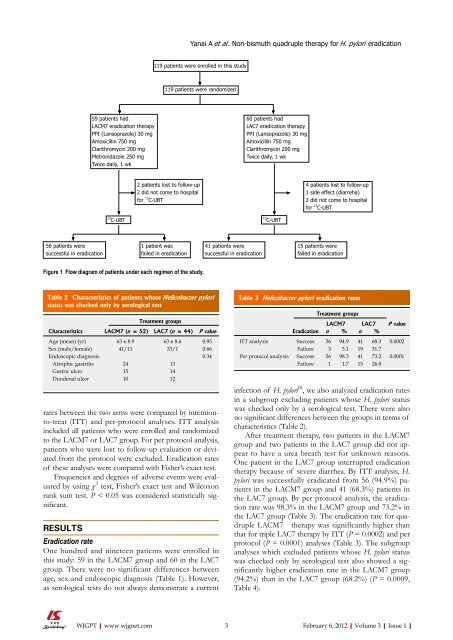World Journal of Gastrointestinal Pharmacology and Therapeutics
World Journal of Gastrointestinal Pharmacology and Therapeutics
World Journal of Gastrointestinal Pharmacology and Therapeutics
You also want an ePaper? Increase the reach of your titles
YUMPU automatically turns print PDFs into web optimized ePapers that Google loves.
56 patients were<br />
successful in eradication<br />
rates between the two arms were compared by intentionto-treat<br />
(ITT) <strong>and</strong> per-protocol analyses. ITT analysis<br />
included all patients who were enrolled <strong>and</strong> r<strong>and</strong>omized<br />
to the LACM7 or LAC7 group. For per protocol analysis,<br />
patients who were lost to follow-up evaluation or deviated<br />
from the protocol were excluded. Eradication rates<br />
<strong>of</strong> these analyses were compared with Fisher’s exact test.<br />
Frequencies <strong>and</strong> degrees <strong>of</strong> adverse events were evaluated<br />
by using χ 2 test, Fisher’s exact test <strong>and</strong> Wilcoxon<br />
rank sum test. P < 0.05 was considered statistically significant.<br />
RESULTS<br />
59 patients had<br />
LACM7 eradication therapy<br />
PPI (Lansoprazole) 30 mg<br />
Amoxicillin 750 mg<br />
Clarithromycin 200 mg<br />
Metronidazole 250 mg<br />
Twice daily, 1 wk<br />
13 C-UBT<br />
Eradication rate<br />
One hundred <strong>and</strong> nineteen patients were enrolled in<br />
this study: 59 in the LACM7 group <strong>and</strong> 60 in the LAC7<br />
group. There were no significant differences between<br />
age, sex <strong>and</strong> endoscopic diagnosis (Table 1). However,<br />
as serological tests do not always demonstrate a current<br />
WJGPT|www.wjgnet.com<br />
119 patients were enrolled in this study<br />
1 patient was<br />
failed in eradication<br />
119 patients were r<strong>and</strong>omized<br />
2 patients lost to follow-up<br />
2 did not come to hospital<br />
for 13 C-UBT<br />
Figure 1 Flow diagram <strong>of</strong> patients under each regimen <strong>of</strong> the study.<br />
Table 2 Characteristics <strong>of</strong> patients whose Helicobacter pylori<br />
status was checked only by serological test<br />
Treatment groups<br />
Characteristics LACM7 (n = 52) LAC7 (n = 44) P value<br />
Age (mean) (yr) 63 ± 8.9 63 ± 8.6 0.95<br />
Sex (male/female) 41/11 33/1 0.66<br />
Endoscopic diagnosis 0.34<br />
Atrophic gastritis 24 13<br />
Gastric ulcer 15 14<br />
Duodenal ulcer 10 12<br />
Yanai A et al . Non-bismuth quadruple therapy for H. pylori eradication<br />
41 patients were<br />
successful in eradication<br />
60 patients had<br />
LAC7 eradication therapy<br />
PPI (Lansoprazole) 30 mg<br />
Amoxicillin 750 mg<br />
Clarithromycin 200 mg<br />
Twice daily, 1 wk<br />
13 C-UBT<br />
4 patients lost to follow-up<br />
1 side effect (diarreha)<br />
2 did not come to hospital<br />
for 13 C-UBT<br />
15 patients were<br />
failed in eradication<br />
Table 3 Helicobacter pylori eradication rates<br />
Treatment groups<br />
LACM7 LAC7 P value<br />
Eradication n % n %<br />
ITT analysis Success 56 94.9 41 68.3 0.0002<br />
Failure 3 5.1 19 31.7<br />
Per protocol analysis Success 56 98.3 41 73.2 0.0001<br />
Failure 1 1.7 15 26.8<br />
infection <strong>of</strong> H. pylori [5] , we also analyzed eradication rates<br />
in a subgroup excluding patients whose H. pylori status<br />
was checked only by a serological test. There were also<br />
no significant differences between the groups in terms <strong>of</strong><br />
characteristics (Table 2).<br />
After treatment therapy, two patients in the LACM7<br />
group <strong>and</strong> two patients in the LAC7 group did not appear<br />
to have a urea breath test for unknown reasons.<br />
One patient in the LAC7 group interrupted eradication<br />
therapy because <strong>of</strong> severe diarrhea. By ITT analysis, H.<br />
pylori was successfully eradicated from 56 (94.9%) patients<br />
in the LACM7 group <strong>and</strong> 41 (68.3%) patients in<br />
the LAC7 group. By per protocol analysis, the eradication<br />
rate was 98.3% in the LACM7 group <strong>and</strong> 73.2% in<br />
the LAC7 group (Table 3). The eradication rate for quadruple<br />
LACM7 therapy was significantly higher than<br />
that for triple LAC7 therapy by ITT (P = 0.0002) <strong>and</strong> per<br />
protocol (P = 0.0001) analyses (Table 3). The subgroup<br />
analyses which excluded patients whose H. pylori status<br />
was checked only by serological test also showed a significantly<br />
higher eradication rate in the LACM7 group<br />
(94.2%) than in the LAC7 group (68.2%) (P = 0.0009,<br />
Table 4).<br />
3 February 6, 2012|Volume 3|Issue 1|

















